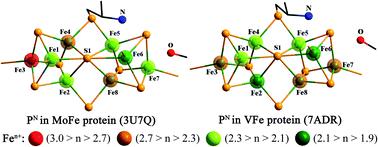Our official English website, www.x-mol.net, welcomes your
feedback! (Note: you will need to create a separate account there.)
Statistical analysis of PN clusters in Mo/VFe protein crystals using a bond valence method toward their electronic structures
RSC Advances ( IF 3.9 ) Pub Date : 2022-02-11 , DOI: 10.1039/d1ra08507g Chang Yuan 1 , Wan-Ting Jin 1 , Zhao-Hui Zhou 1
RSC Advances ( IF 3.9 ) Pub Date : 2022-02-11 , DOI: 10.1039/d1ra08507g Chang Yuan 1 , Wan-Ting Jin 1 , Zhao-Hui Zhou 1
Affiliation

|
Nowadays, large numbers of MoFe proteins have been reported and their crystal data obtained by X-ray crystallography and uploaded to the Protein Data Bank (PDB). By big data analysis using a bond valence method, we make conclusions based on 79 selected PN in all 119 P-clusters of 53 MoFe proteins and 10 P-clusters of 5 VFe proteins from all deposited crystallographic data of the PDB. In the condition of MoFe protein crystals, the resting state PN clusters are proposed to have the formal oxidation state of 2Fe(III)6Fe(II), hiding two oxidized electron holes with high electron delocalization. The calculations show that Fe1, Fe2, Fe5, Fe6 and Fe7 perform unequivocally as Fe2+, and Fe3 is remarkably prone to Fe(III), while Fe4 and Fe8 have different degrees of mixed valences. For PN clusters in VFe protein crystals, Fe1, Fe2, Fe4, Fe5 and Fe6 tend to be Fe2+, but the electron distributions rearrange with Fe7 and Fe8 being more oxidized mixed valences, and Fe3 presenting a little more reductive mixed valence than that in MoFe proteins. In terms of spatial location, Fe3 and Fe6 in P-clusters of MoFe proteins are calculated as the most oxidized and reduced irons, which have the shortest distances from homocitrate in the FeMo-cofactor and [Fe4S4] cluster, respectively, and thus could function as potential electron transport sites. This work shows different electron distributions of PN clusters in Mo/VFe protein crystals, from those obtained from previous data from solution with excess reducing agent from which it was concluded that PN clusters are all ferrous according to Mössbauer and electron paramagnetic resonance spectra.
中文翻译:

使用键价法对其电子结构进行 Mo/VFe 蛋白质晶体中 PN 簇的统计分析
如今,已经报道了大量的MoFe蛋白,并通过X射线晶体学获得了它们的晶体数据并上传到蛋白质数据库(PDB)。通过使用键价方法的大数据分析,我们根据 PDB 的所有沉积晶体学数据中 53 个 MoFe 蛋白的所有 119 个 P 簇和 5 个 VFe 蛋白的 10 个 P 簇中选定的 79 个 P N得出结论。在MoFe蛋白质晶体的条件下,静止态P N团簇被认为具有2Fe( III )6Fe( II )的形式氧化态,隐藏了两个具有高电子离域性的氧化电子空穴。计算表明,Fe1、Fe2、Fe5、Fe6 和 Fe7 明显表现为 Fe 2+ ,Fe3 明显倾向于 Fe( III ) ,而 Fe4 和 Fe8 具有不同程度的混合价态。对于VFe蛋白晶体中的P N团簇,Fe1、Fe2、Fe4、Fe5和Fe6倾向于Fe 2+ ,但电子分布重新排列,Fe7和Fe8呈氧化性混合价,Fe3呈现稍还原性混合价。 MoFe 蛋白质中的那个。就空间位置而言,MoFe蛋白P簇中的Fe3和Fe6被计算为最氧化和还原的铁,它们分别与FeMo-辅因子和[Fe 4 S 4 ]簇中的高柠檬酸距离最短,并且因此可以充当潜在的电子传输位点。 这项工作显示了 Mo/VFe 蛋白质晶体中 P N簇的不同电子分布,与之前从含有过量还原剂的溶液中获得的数据相比,根据穆斯堡尔谱和电子顺磁共振谱得出结论,P N簇都是亚铁的。
更新日期:2022-02-11
中文翻译:

使用键价法对其电子结构进行 Mo/VFe 蛋白质晶体中 PN 簇的统计分析
如今,已经报道了大量的MoFe蛋白,并通过X射线晶体学获得了它们的晶体数据并上传到蛋白质数据库(PDB)。通过使用键价方法的大数据分析,我们根据 PDB 的所有沉积晶体学数据中 53 个 MoFe 蛋白的所有 119 个 P 簇和 5 个 VFe 蛋白的 10 个 P 簇中选定的 79 个 P N得出结论。在MoFe蛋白质晶体的条件下,静止态P N团簇被认为具有2Fe( III )6Fe( II )的形式氧化态,隐藏了两个具有高电子离域性的氧化电子空穴。计算表明,Fe1、Fe2、Fe5、Fe6 和 Fe7 明显表现为 Fe 2+ ,Fe3 明显倾向于 Fe( III ) ,而 Fe4 和 Fe8 具有不同程度的混合价态。对于VFe蛋白晶体中的P N团簇,Fe1、Fe2、Fe4、Fe5和Fe6倾向于Fe 2+ ,但电子分布重新排列,Fe7和Fe8呈氧化性混合价,Fe3呈现稍还原性混合价。 MoFe 蛋白质中的那个。就空间位置而言,MoFe蛋白P簇中的Fe3和Fe6被计算为最氧化和还原的铁,它们分别与FeMo-辅因子和[Fe 4 S 4 ]簇中的高柠檬酸距离最短,并且因此可以充当潜在的电子传输位点。 这项工作显示了 Mo/VFe 蛋白质晶体中 P N簇的不同电子分布,与之前从含有过量还原剂的溶液中获得的数据相比,根据穆斯堡尔谱和电子顺磁共振谱得出结论,P N簇都是亚铁的。











































 京公网安备 11010802027423号
京公网安备 11010802027423号